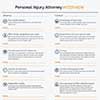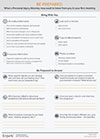
Learn how Iowa is tackling the distracted driving epidemic
This article examines the issue of distracted driving in Iowa, discussing the laws in place to combat this growing problem, the penalties for violating these laws, and the legal steps to take if you've been injured in an accident caused by a distracted driver.
Imagine driving along Interstate 80, enjoying the picturesque views of Iowa's rolling farmland, when suddenly, a distracted driver drifts into your lane, causing a devastating accident.
This scenario is all too common, as distracted driving has become one of the leading causes of car accidents in Iowa and across the United States. In this article, we'll explore Iowa's distracted driving laws, the penalties, and the steps to take if you've been injured in an accident caused by a distracted driver.
Distracted driving is a growing problem on Iowa’s roads
Distracted driving is defined as engaging in any activity that diverts a driver’s attention away from the primary task of driving.
Common distractions include:
- Cell phones
- Grooming
- Eating or drinking
- Adjusting the radio
- Interacting with passengers
Most people believe they’re capable of multitasking but, as psychologist Daniel Simons explains, “multitasking” is actually the brain switching back and forth between tasks rapidly. You can’t actually focus on driving and another task at the same time. In fact, it takes an average of 5 seconds to read a text, which means that, if you’re traveling 55 miles per hour, you’ll have traveled the equivalent length of a football field blindfolded.
According to the National Highway Traffic Safety Administration (NHTSA), roughly nine people are killed every day in the United States in crashes involving a distracted driver.
In Iowa, distracted driving accidents have resulted in roughly 14 fatalities every year. What’s more, the Iowa State Patrol believes this reported number is too low.
“We’re just trying to really drive down our fatality rate here in Iowa,” said Ryan DeVault of the Iowa State Patrol. “And honestly, the distracted driving statistics that anybody can look up, we in law enforcement believe that those are probably underreported.”
Drivers who use hand-held devices while driving are 4 times as likely to get into crashes serious enough to injure themselves or others, according to the Iowa Department of Public Safety. Young drivers under 20 years old have the highest proportion of distraction-related fatal crashes.
Iowa’s texting and driving ban
To combat the dangers posed by distracted driving, Iowa has implemented strict laws that prohibit specific distractions. The most notable law focuses on cell phone use, as cell phones are the leading cause of distraction-related accidents.
Under Iowa Code § 321.276, it is illegal for all drivers, regardless of age, to read, write, or send a text message or other electronic communication while operating a motor vehicle.
Drivers over the age of 18 may use their phones to talk (not text) while driving and as a GPS navigation system. Drivers under the age of 18, on the other hand, are prohibited from talking on their phones, even when using a hands-free device.
Penalties for violating Iowa’s texting and driving ban
Iowa’s texting and driving law is a primary enforcement law, which means law enforcement officers can pull over and ticket drivers for texting and driving, even if no other traffic violation occurred.
The penalty for violating the texting and driving ban is a $45 fine. At the time of this writing, legislation has been introduced that would increase the $45 fine.
What’s more, a driver using a cellphone and causing the death of another person could face a felony conviction that includes up to 10 years in prison and a fine of up to $10,000.
Distracted driving and personal injury cases
The fines for texting and driving are relatively minor in Iowa. The real consequences arise when a distracted driver is involved in a car accident.
Under Iowa law, a driver is negligent if they fail to use reasonable care and someone is harmed because of that failure. When a driver causes a car accident because they were texting and driving, the driver is negligent and responsible for paying the damages caused by the accident.
Evidence that can help prove distracted driving in a personal injury case may include:
- Police reports that document the at-fault driver's distracted behavior
- Witness statements corroborating the driver's distraction
- Cell phone records demonstrating the driver's phone use at the time of the accident
- Traffic camera footage capturing the driver's actions leading up to the crash
Iowa’s comparative fault rule in distracted driving cases
Iowa follows a modified comparative fault system, which may impact the amount of compensation you can recover in a personal injury case.
Under Iowa’s modified comparative fault rule, an injured person can recover damages even if they were partially responsible for the accident, but their damages will be reduced according to their percentage of fault. What’s more, if the person is more than 50 percent at fault, they are barred from recovering any damages.
Confused?
Here’s an example to clear things up:
Jane and Kevin are involved in a car accident in Iowa. Jane is driving her car and is distracted because she’s texting her husband on her cellphone. At the same time, Kevin is also distracted because he’s eating a sandwich while driving. As a result, both fail to notice a stop sign and their cars collide.
Kevin files a lawsuit against Jane for $100,000.
Under Iowa’s modified fault rule, each driver is assigned a degree of fault, and the plaintiff’s recoverable damages are reduced accordingly. In this case, let’s assume the court determines that:
- Jane was 60 percent at fault for the accident because she was texting while driving.
- Kevin was 40 percent at fault for the accident because he was eating a sandwich while driving.
Now, the modified comparative fault rule comes into play. Since Kevin is 40 percent at fault, his recoverable damages will be reduced by his percentage of fault. So, he can recover 60 percent of his total damages:
- $100,000 (total damages) x 60 percent (100 percent - 40 percent fault) = $60,000.
When to consult a personal injury attorney in Iowa
If you've been injured in a distracted driving accident, it's important to seek legal advice from an experienced Iowa personal injury attorney. A skilled attorney can help you:
- Understand your legal rights and options
- Investigate and gather evidence to prove the other driver's distracted behavior
- Calculate the full extent of your damages, including current and future medical expenses, lost wages, and pain and suffering
- Negotiate with insurance companies on your behalf
- Represent your best interests in trial, if necessary
By working with a knowledgeable attorney, you increase your chances of obtaining fair and just compensation for your injuries and losses. Most attorneys offer free initial consultations, which gives you an opportunity to find out whether the attorney is right for your case.

Worksheet with questions to ask a personal injury attorney to help determine if he or she will be a good fit for your case
Download in PDF format

A worksheet to prepare for your first meeting with a personal injury attorney – what to bring, what they'll ask
Download in PDF format
See our guide Choosing a personal injury attorney.
